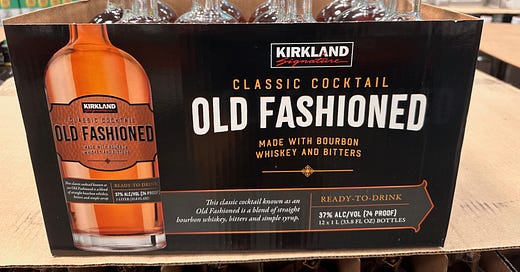Costco’s Bottled Old Fashioned Is Actually Kind of OK?
It's not great. But in the right circumstances, it might be good enough.
In general, I have not been very impressed with ready-to-drink cocktails.
No, I have not tried every single option on the market or conducted an in-depth survey. I am open to having my mind changed. But in my limited, idiosyncratic experience, pre-made, store-bought cocktails—especially those that come in single-serve containers—tend to fall somewhere between not-quite-good-enough-to-finish and so-bad-I-wonder-if-the-producers-have-ever-tasted-a-good-cocktail. Some of these single-serve options, meanwhile, are relatively expensive, running $5 or more for a single drink.1
So I was surprised to discover that Costco’s house brand bottled Old Fashioned is kind of, sort of, almost maybe, an exception. And thinking about why and how it works, and what it’s good for, provides an opportunity to think more generally about the various factors and tradeoffs that determine whether a drink is a good value proposition.
Is this a delicious drink is always an important question, and it’s one we ask a lot in this newsletter, which is, after all, devoted to making delicious drinks. But it’s not the only relevant question. Not always.
In this case, the answer is that Kirkland Signature Old Fashioned does not make for a great cocktail. I’m not even sure it makes for a good cocktail. The whiskey recedes into the background. The bitters are too aggressive, with the clove note slightly too pronounced. The sweetness level is somewhere in the vicinity of correct, but lacks the flavor of rich Demerara or even maple syrup, and the drink doesn’t have the slightly viscous, molasses-y body weight and mouthfeel of a truly excellent Old Fashioned.
But pour two ounces of Kirkland Signature Old Fashioned over ice and add a twist of orange peel and it comes shockingly close to producing a mostly tolerable, not-too-bad, basically drinkable cocktail. If I were served a drink like this at a restaurant, I am not sure I would order another one, but I would probably finish the drink. Which is a lot more than I can say for some other ready to drink cocktails. Or even restaurant cocktails.
And in one important way, I much prefer this to a middling restaurant Old Fashioned: It is much, much less expensive.
These days, even mediocre cocktails at restaurants that don’t have high quality bar programs, can run $16. I’ve been to fancy hotel bars—often the worst offenders in terms of cost/quality balance—that serve nearly undrinkable versions of classics at price tags north of $20. I will happily pay that for a truly well made drink at a top notch cocktail bar. But a $20 price tag on a lousy Old Fashioned drives me nuts, even if it’s at an event where someone else is paying.
The Kirkland Signature Old Fashioned, on the other hand, runs $18–for the entire bottle. And the bottle is a full liter, or about 33.8 ounces. By my writer math, that comes out to about 53 cents per ounce. With a two ounce pour, that’s just over a dollar per drink.
Now, with a little work, you can make a very serviceable, even quite good, Old Fashioned at home for about $1. But “a little work” and “at home” are important caveats.
When considering the value proposition of a cocktail, you have to consider three main factors.
Cost: The unit cost of most drinks made at home typically comes in around $3-4, maybe a little more depending on what drink you’re making and what ingredients you’re using. Even the most expensive made-at-home cocktails tend to be quite a bit cheaper than at bars, which frequently aim to keep the pour cost of a drink at no more than 20 percent of the menu price.
Quality: Is the drink any good? Is it tasty, interesting, well-made? A high-end cocktail joint with well-trained bartenders is going to score very high on the quality metric. A drink served at home may not. Making high quality drinks at home is obviously possible, but it requires some skills, knowledge, practice, and technique. (That’s why you subscribe to this newsletter!)
Ease and convenience: Making drinks at home requires time, tools, and ingredients. You have to get out the bottles and the tools. You have to find and select recipes. You may have to make syrups, or squeeze citrus, or juice a pineapple. (You should really juice your own pineapple.) Even if you have a dedicated home bar, you have to devote some portion of your house to it. And you have to clean it, maintain it, wash your own glassware, and so forth. It’s not necessarily difficult, not like climbing Mount Everest is difficult, and one can make the case that home bars are more convenient just because you don’t have to go anywhere. Readers of a newsletter dedicated to the craft of home bartending are more likely to find this sort of thing enjoyable or interesting. But for many people, it’s a lot of work for a drink. Bars and bartenders handle all of the cleaning/prepping/ingredient acquisition/bartending for you. They’re also just pleasant spaces.
Most cocktails that are worthwhile score high in two out of three factors: Well-made drinks at home offer quality at a comparatively low cost. Well-made drinks at bars offer quality, plus ease and convenience—but at a higher cost.
A bottle of Kirkland Signature Old Fashioned isn’t the greatest liquid you will ever drink. But it scores quite high on cost and convenience: The cost is competitive with the most affordable homemade cocktails, and there’s almost no prep necessary, aside from purchasing the bottle. The quality may not be exceptionally high, but it’s not quite so low that it rules out the option entirely
That’s especially true when more conventional homemade drinks are not possible—for example, if you are traveling.
In the Reddit discussion of the Costco Old Fashioned, at least one poster brought up long business trips. That seems to me like the perfect use case for this sort of thing.
Every now and then I find myself spending a night or two at the Country Inn & Suites class of hotel. Invariably, there are guests who have set up camp for longer, obviously work-related stays—in many cases, I suspect, for IT installation projects. These are the guests who hang out in the courtyard and use the grills and treat the hotel more like a very short-term apartment.
Is someone on a three-week business trip going to blend Demerara syrup and cart around bitters and a dedicated spoon and mixing glass? Maybe. I’ve traveled with cocktail tools before and set up small home bars for long weekends away with friends. But I wouldn’t try to argue that my behavior in that regard is remotely normal.
For many folks in such settings—even those who might otherwise make the effort to mix themselves a cocktail at home—the ease and convenience factor ends up being the overriding concern. Kirkland Signature Old Fashioned absolutely maximizes the ease and convenience part of the equation, and it does so at a competitively low price point.
It’s definitely not a great Old Fashioned. But it’s not terrible either. In the right circumstances, for the right person, it might be a good enough Old Fashioned. And sometimes good enough will do.
Two Big Dogs Who Are Better Than Good Enough
I can’t prove it, but I suspect the business model for some of these brands is built around using packaging, branding, and other marketing tricks to boost the sale price, at least on a per-ounce basis, of relatively inexpensive, poorly mixed liquor.





The old fashion mixes frequently make for good bases of Wisconsin old fashioneds - especially family parties where they think real old fashioneds are undrinkable.
Nice writeup. Not something I'd buy for home - even if it tasted great, I enjoy variety too much to dedicate the shelf space to a single drink (though I suppose that's what my bottles of single malt scotch are...). But to bring to a family get-together like I'd bring wine, not a bad idea!
It occurs to me that Costco also made a smart call with the choice of cocktail here - the ingredients of an old fashioned are all shelf stable and don't degrade quickly, so while the quality of the ingredients may not be high, the fact that they're premixed is probably not a major issue. Unlike, say, any cocktail with a fruit juice component.